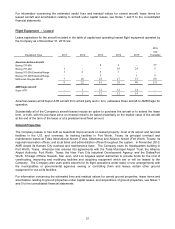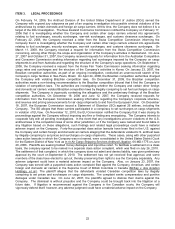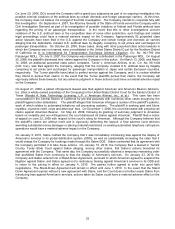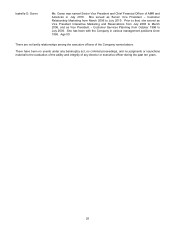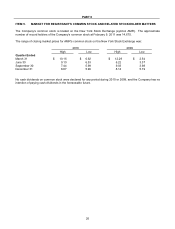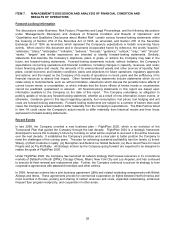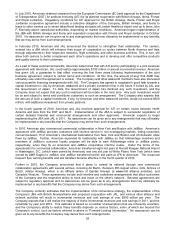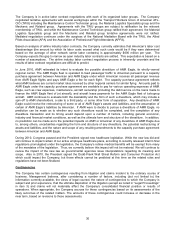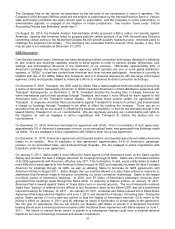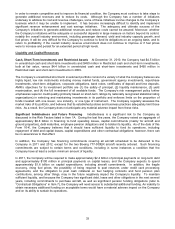American Airlines 2010 Annual Report Download - page 33
Download and view the complete annual report
Please find page 33 of the 2010 American Airlines annual report below. You can navigate through the pages in the report by either clicking on the pages listed below, or by using the keyword search tool below to find specific information within the annual report.
30
The Company is in active labor contract negotiations with each of its organized labor groups. The Company
negotiated tentative agreements with several workgroups within the Transport Workers Union of American AFL-
CIO (TWU) including the Maintenance Control Technician group, the Material Logistics Specialists group and the
Mechanic and Related group. Agreements with the TWU groups are subject to ratification by the relevant
membership of TWU, and while the Maintenance Control Technician group ratified their agreement, the Material
Logistics Specialists group and the Mechanic and Related group tentative agreements were not ratified.
Mediated negotiation continues under the auspices of the National Mediation Board with the TWU, the Allied
Pilots Association (APA) and the Association of Professional Flight Attendants (APFA).
Based on analysis of airline industry labor contracts, the Company currently estimates that American’s labor cost
disadvantage (the amount by which its labor costs exceed what such costs would be if they were determined
based on the average of other network carrier labor contracts) is approximately $600 million per year. The
Company expects this gap to narrow as open industry labor contracts are settled. This expectation is based on a
number of assumptions. The airline industry labor contract negotiation process is inherently uncertain and the
results of labor contract negotiations are difficult to predict.
In June 2010, AMR reiterated its intent to evaluate the possible divestiture of AMR Eagle, its wholly−owned
regional carrier. The AMR Eagle fleet is operated to feed passenger traffic to American pursuant to a capacity
purchase agreement between American and AMR Eagle under which American receives all passenger revenue
from AMR Eagle flights and pays AMR Eagle a fee for each flight. The capacity purchase agreement reflects
what AMR believes are current market rates received by other regional carriers for similar flying. Amounts paid to
AMR Eagle under the capacity purchase agreement are available to pay for various operating expenses of AMR
Eagle, such as crew expenses, maintenance, aircraft ownership (including the debt service on the loans made to
finance the AMR Eagle fleet of jet aircraft), and aircraft lease payments for the AMR Eagle fleet of turboprop
aircraft. AMR continues to evaluate both the desirability and the form of such a divestiture, which may include a
spin-off to AMR shareholders, a sale to a third party, or some other form of separation. Any divestiture of AMR
Eagle could involve the restructuring of some or all of AMR Eagle’s assets and liabilities, and the assumption of
certain of AMR Eagle’s liabilities by American. If AMR were to decide to pursue a divestiture of AMR Eagle, no
prediction can be made as to whether any such divestiture would be completed, and the completion of any
divestiture transaction and its timing would depend upon a number of factors, including general economic,
industry and financial market conditions, as well as the ultimate form and structure of the divestiture. In addition,
no prediction can be made as to the potential impacts on AMR or American of any divestiture of AMR Eagle due
to, among others, uncertainties regarding the form and structure of any divestiture, the potential restructuring of
assets and liabilities, and the nature and scope of any resulting amendments to the capacity purchase agreement
between American and AMR Eagle.
During 2010, Congress passed and the President signed new healthcare legislation. While the new law did and
will continue to impact certain of our active employee healthcare plans, according to recently released interim final
regulations promulgated under the legislation, the Company’s retiree medical benefits will be exempt from many
of the mandates of the legislation. Thus, we currently believe this impact will not be material. We will continue to
review the impact of the new law as governmental agencies issue interpretations regarding its meaning and
scope. Also in 2010, the President signed the Dodd-Frank Wall Street Reform and Consumer Protection Act
which could impact the Company, but those effects cannot be predicted at this time as the related rules and
regulations have not been finalized.
Contingencies
The Company has certain contingencies resulting from litigation and claims incident to the ordinary course of
business. Management believes, after considering a number of factors, including (but not limited to) the
information currently available, the views of legal counsel, the nature of contingencies to which the Company is
subject and prior experience, that the ultimate disposition of the litigation (except as noted in “Legal Proceedings”
in item 3) and claims will not materially affect the Company’s consolidated financial position or results of
operations. When appropriate, the Company accrues for these contingencies based on its assessments of the
likely outcomes of the related matters. The amounts of these contingencies could increase or decrease in the
near term, based on revisions to those assessments.



